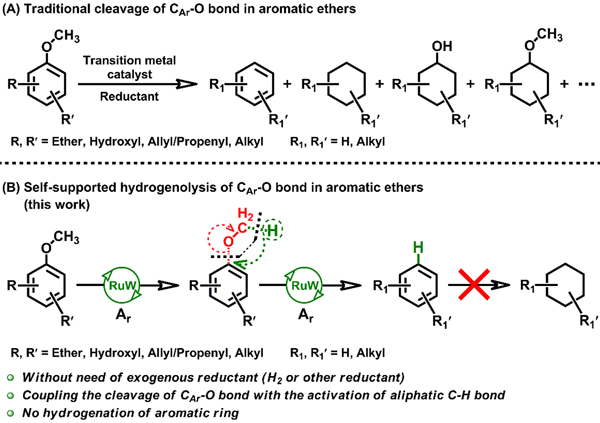A strategy to production of arenes from renewable feedstock
Utilization of biomass as raw materials to produce useful chemicals and fuels can liberate us from the reliance on fossil resource and can also be considered as recycling of CO2 by combination of photosynthesis and chemical methods. Arenes are widely used chemicals and essential components in liquid fuels, which are currently produced from fossil feedstocks. With a benzene ring as its main structural characteristic, biomass-derived aromatic ethers can be potentially used to produce industrially relevant aromatic bulk and fine chemicals. But cleavage of the aryl carbon-oxygen (CAr-O) bond is necessary.
It is known that hydrodeoxygenation (HDO) is efficient method to cleave CAr-O bond with hydrogen present, which should be the convenient and feasible pathway to produce aromatic hydrocarbons. However, in the conventional HDO reactions, the concomitant hydrogenation of the aromatic ring cannot be avoided completely because hydrogen is used as reductant (Figure B). Recently, the research group led by Buxing Han at the Institute of Chemistry, Chinese Academy of Sciences, proposed the self-supported hydrogenolysis (SSH) of aromatic ethers to produce arenes using the hydrogen source within the reactants, and it was found that RuW alloy nanoparticles were very efficient catalyst for the reactions. This route is very attractive and distinguished from the reported studies on the cleavage of the CAr─O bonds. The unique feature of this methodology is that exogenous hydrogen or other reductant is not required, and hydrogenation of aromatic rings could be avoided completely (Figure B). The selectivities to arenes could reach >99.9% at complete conversion of the ethers. Moreover, lignin, a major component of lignocellulosic biomass, could also be transformed into arenes efficiently over the RuW alloy catalyst. The mechanism studies showed that the neighboring Ru and W species in the RuW alloy nanoparticles worked synergistically to accelerate the SSH reaction. The hydrogen-free and highly efficient methodology has great application potential to produce arenes from renewable biomass resources, and the scientific discovery is instructive for the exploration of some other new reactions. The work entitled “Self-supported hydrogenolysis of aromatic ethers to arenes” were recently published in Science Advances (2019, 5, eaax6839).
The work was supported financially by the National Key Research and Development Program of China, the National Natural Science Foundation of China, and the Beijing Municipal Science and Technology Commission.

The SSH route to sustainably produce arenes from natural aromatic ethers. (Image by Prof. HAN Buxing)
Contact:
Prof. HAN Buxing
Institute of Chemistry, Chinese Academy of Sciences
Email: hanbx@iccas.ac.cn





